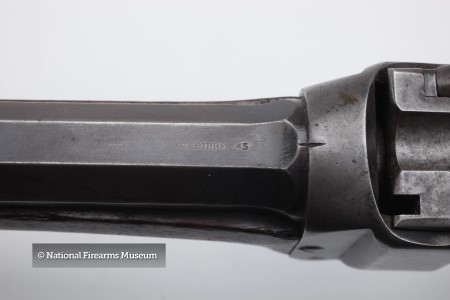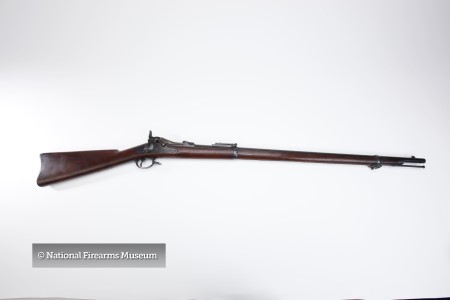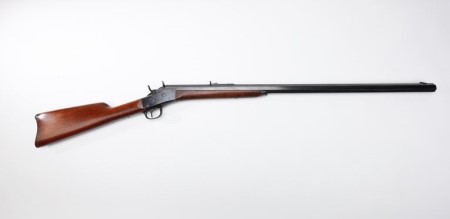During the early 1800s, when American frontiersmen were first crossing the Mississippi and heading west, they encountered areas of both short-grass and tall-grass prairies so vast they appeared as seas. When the wind blew, which was most of the time, those breezes caused the grass to undulate in waves. Living upon those seemingly endless grasslands were immense herds of bison, also known as buffalo. The largest land mammal in North America, an estimated 30 million to 60 million bulls, cows, yearlings and calves once grazed the Great Plains.
Those first frontiersmen engaged in subsistence hunting, shooting an occasional buffalo for food. But it wasn’t long before some of the hunters realized that, given such an abundant natural resource, there was a dollar to be made from the animals. Actually, many dollars. So, by the late 1800s, literally thousands of professional buffalo hunters were prowling the prairies in search of the wandering herds for their meat, hides and tongues—buffalo tongue was a delicacy served in restaurants back East.
Professional buffalo hunters had several requirements of their rifles. The guns had to be rugged, reliable, accurate at long range, and of large enough caliber (.44, .45 or .50) to bring down a heavy-boned animal that might weigh as much as a ton. The following three single-shot, breechloading, black-powder rifles checked all of those boxes, and were the most popular with buffalo hunters.

Sharps Model 1874
Nicknamed “Old Reliable,” this particular Sharps rifle was a favorite of buffalo hunters due to its long-range accuracy. Sharps rifles were commonly used during the Civil War (1861-1865), with sporting versions manufactured for 40 years, from the late 1840s to the late 1880s. After the war, the Sharps factory produced Models 1869 and 1874 in large quantities for commercial buffalo hunters and competition shooters. These heavy, large-bore rifles, weighing nearly 10 pounds, were manufactured knowing that they would be firing some of the most powerful black-powder cartridges ever made.
In more modern times, Sharps rifles have become icons of the Old West, appearing in many books and several movies; three of the most familiar films being Quigley Down Under (1990) and True Grit (1969, 2010). Reproduction Sharps are still offered today by several firearms manufacturers.

Springfield Model 1873 Trapdoor
The first standard-issue, breechloading rifle adopted by the U.S. Army, this gun had two versions. One featured a full-length barrel and stock; the other, a shorter carbine barrel and stock, for use by cavalry soldiers.
The cartridge that the full-length rifle fired was labeled .45-70-405, meaning that it was .45 caliber, propelled by 70 grains of black powder, pushing a 405-grain bullet. The cavalry version of the cartridge was a little lighter to help ease recoil for a mounted soldier. The “trapdoor” designation comes from the fact that a hinged breechblock had to be rotated up and forward before loading or unloading the gun.
This rifle saw extensive use during the Indian Wars on the Great Plains, so there were plenty of the guns around with which to shoot buffalo. An interesting bit of history is that this is one of the main rifles that General George Armstrong Custer’s 7th Cavalry carried into the fight at the Battle of the Little Bighorn.

Remington Number 1 Rolling Block
The NRA Museum’s (www.nramuseum.org) description of this rifle reads:
“Although chambered for military cartridges, many Remingtons were also used by civilian buyers. The No. 1 Rolling Block was produced circa 1868-1888. After the Civil War, a rush of settlers moved west of the Mississippi. Meat and hides were sought. Buffalo provided both of these, and a gun that could kill buffalo with one shot was needed. In 1868, Remington Arms Company of Ilion, New York, filled this need with the Sporting Rifle Number 1.
“This rifle featured one of the strongest receivers ever made. Called a rolling block, it rotates at its breech a large, round block behind a cartridge. A large, round hammer, in turn, supports the block. Firing a .45-70 cartridge, the rifle can bring down most anything at long range. The Remington No. 1 was among the most prolifically produced firearms of its time.”
On the Prairie
In the hands of an experienced marksman, any of those three rifles were deadly. Buffalo hunters would first locate a herd from horseback, then, by approaching on foot downwind of the animals, attempt to stalk undetected within a couple hundred yards—even closer if the terrain allowed. The first animal killed would be the herd leader, usually an older cow buffalo. The idea was to not spook and stampede the herd; but rather to take your time shooting, cleanly killing one animal after another, one shot one kill. Using that practiced technique, a skilled shooter might kill 100 buffalo or more in a single day.
Some buffalo hunters became so proficient that they were well known on the plains: Cross-Eyed Joe, Apache Bill, Buffalo Curley, Limpy Jim Smith, Buckshot Roberts, Squirrel Eye Emery, Prairie Dog Dave, California Joe … the list goes on.
Likely the most famous hunter was William Frederick “Buffalo Bill” Cody. Shortly after the Civil War, he signed a contract to supply Kansas Pacific Railroad workers with buffalo meat. Cody was so adept as a hunter that during one 18-month period spanning 1867 and 1868, he is purported to have killed 4,282 of the large, wooly animals.
But another hunter, Buffalo Bill Comstock, challenged Cody’s right to exclusive use of the nickname Buffalo Bill. To decide the matter, the pair agreed to an eight-hour hunt. Cody won by shooting 68 buffalo compared to Comstock’s 48. It is believed Comstock used a .44-caliber Henry lever-action rifle, while Cody used a .50-caliber Springfield Model 1866.
Cody would one day go on to form his extremely successful traveling extravaganza, Buffalo Bill’s Wild West. For 30 years, he toured America, England and Europe with a troupe of genuine cowboys, authentic Indians, horses, cattle, and yes, a small herd of buffalo.








































